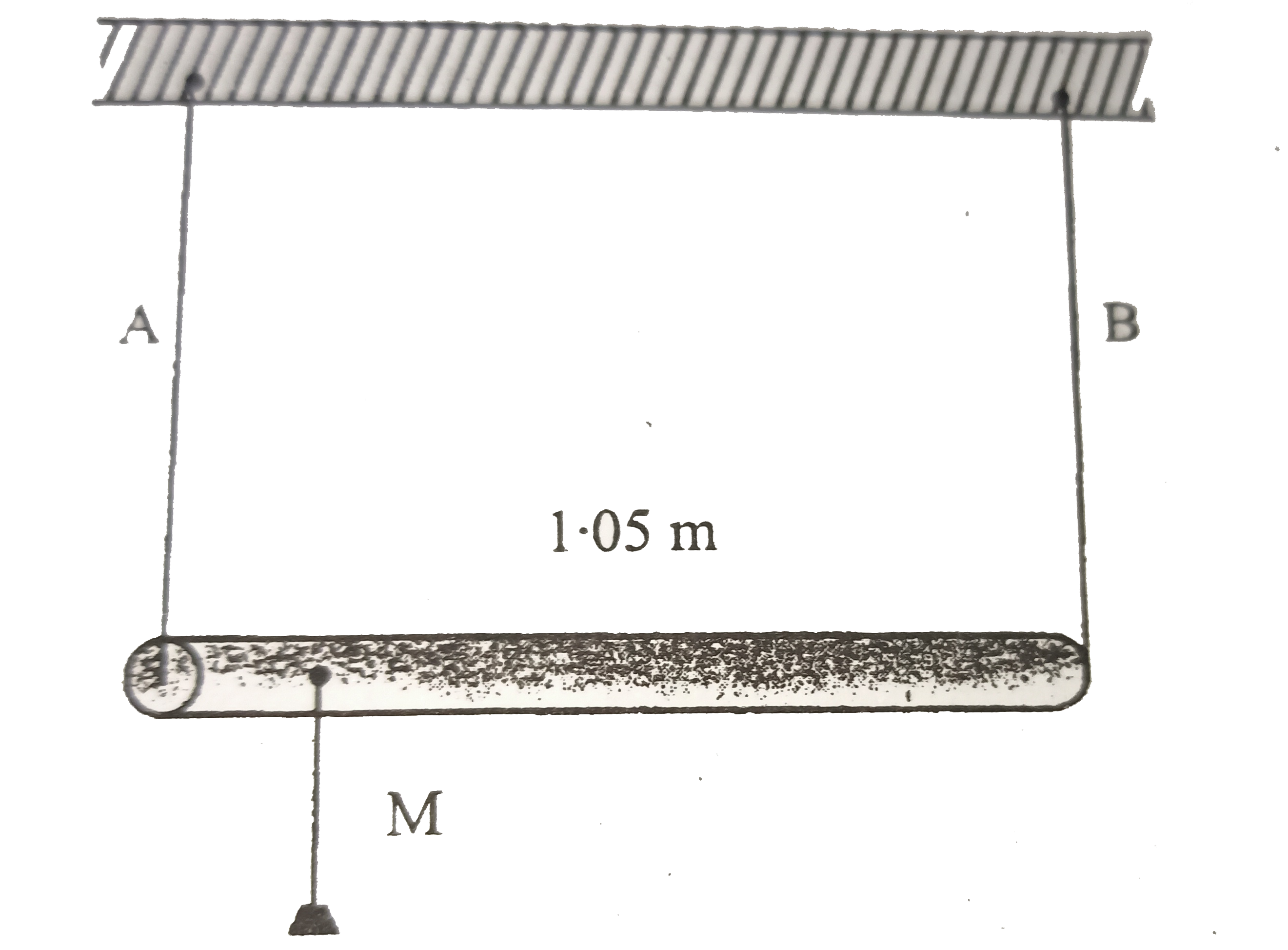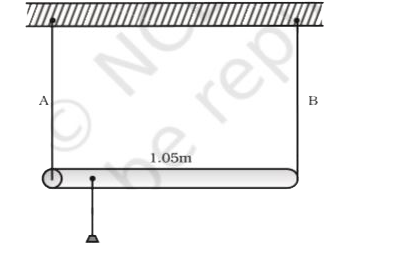A rod of length 1.05 m having negligible mass is supported at its ends by two wires of steel (wire A) and aluminium (wire B) of equal lengths as shown in Fig. 9.15. The cross-sectional areas of wires A and B are , respectively. At what point along the rod should a mass m be suspended in order to produce equal strains in both steel and aluminium wires.:
 Solution in Punjabi
Solution in Punjabi
Step by step video & image solution for A rod of length 1.05 m having negligible mass is supported at its ends by two wires of steel (wire A) and aluminium (wire B) of equal lengths as shown in Fig. 9.15. The cross-sectional areas of wires A and B are 1.0 mm^2 and 2.0 mm^2, respectively. At what point along the rod should a mass m be suspended in order to produce equal strains in both steel and aluminium wires.: by Physics experts to help you in doubts & scoring excellent marks in Class 11 exams.
Updated on:21/07/2023Topper's Solved these Questions
Similar Questions
Answer the following :- You can shield a charge from electrical forces by putting it inside a hollow conductor. Can you shield a body from the gravitational influence of nearby matter by putting it inside a hollow sphere or by some other means ?
View SolutionExplain the term viscosity.
View SolutionA rod of length 1.05 m having negliaible mass is supported at its ends by two wires of steel (wire A) and aluminium (wire B) of equal lengths as shown in fig. The cross-sectional area of wire A and B are 1mm2 and 2mm2, respectively . At what point along the rod should a mass m be suspended in order to produce (a) equal stresses and (b) equal strains in both steel and aluminium wires. Given,
Ysteel=2×1011Nm−2andY−(aluminium)=7.0×1010N−2

View SolutionA rod of length 1.05 m having negliaible mass is supported at its ends by two wires of steel (wire A) and aluminium (wire B) of equal lengths as shown in fig. The cross-sectional area of wire A and B are 1mm2 and 2mm2, respectively . At what point along the rod should a mass m be suspended in order to produce (a) equal stresses and (b) equal strains in both steel and aluminium wires. Given,
Ysteel=2×1011Nm−2andY−(aluminium)=7.0×1010N−2

View SolutionA rod PQ of length 1.05m having negligible mass is supported at its ends by two wires one of stell (wire A), and the other of aluminium (wire B) of equal lengths as shown in fig. The cross-sectional areas of wires A and B are 1.0mm2 and 2.0mm2 respectively. At what point along the rod a load W be suspended in order to produce
(a) equal stress, (b) equal strains in both steel an aluminium.
(Ysteel=200GPa,Yaluminium=70GPa)

View Solution1.05 m लम्बाई तथा नगण्य द्रव्यमान कि एक छड़ को बराबर लम्बाई के दो तारो , एक इस्पात का (तार A) तथा दूसरे ऐलुमिनियम का तार (तार B) द्वारा सिरों से लटका दिया गया है, जैसे कि चित्र में दिखाया गया है। A तथा B के तारो से अनुप्रस्थ प्रतिच्छेद के क्षेत्रफल क्रमश: 1.0mm2 और 2.0mm2 है। छड़ से कितनी दूर बिंदु से एक द्रव्यमान m को लटका दिया जाए ताकि इस्पात तथा ऐलुमिनियम के तारो में (A) समान प्रतिबल तथा (B) समान विकृति उत्पन्न हो।

View Solution1⋅05 m लंबाई तथा नगण्य द्रव्यमान की एक छड़ को बराबर लंबाई के दो तारों, एक इस्पात का ( तार A ) तथा दूसरा ऐल्युमिनियम का तार ( तार B ) द्वारा सिरों से लटका दिया गया है, जैसा कि चित्र में दिखाया गया है। A तथा B के तारों के अनुप्रस्थ परिच्छेद के क्षेत्रफल क्रमशः 1⋅0mm2 और 2⋅2mm2 हैं। छड़ के किस बिंदु से एक द्रव्यमान M को लटका दिया जाए ताकि इस्पात तथा ऐल्युमिनियम के तारों में (a) समान प्रतिबल तथा (b) समान विकृति उत्पन्न हो ?

View SolutionA rod of length 1.05 m having negligible mass supported at its ends by two wires of steel (wire A) and aluminium (wire B) of equal lengths as shown in respectively. At what point along the rod should a mass m be suspended in order to produce (a) equal stresses and (b) equal strains in both steel and aluminium wires.

View SolutionA rod of length 1.05 m having negligible mass supported at its ends by two wires of steel (wire A) and aluminium (wire B) of equal lengths as shown in respectively. At what point along the rod should a mass m be suspended in order to produce (a) equal stresses and (b) equal strains in both steel and aluminium wires.
View SolutionA rod of length 1.05 m having negliaible mass is supported at its ends by two wires of steel (wire A) and aluminium (wire B) of equal lengths as shown in fig. The cross-sectional area of wire A and B are 1 mm^(2) and 2 mm^(2) , respectively . At what point along the rod should a mass m be suspended in order to produce (a) equal stresses and (b) equal strains in both steel and aluminium wires. Given, Y_(steel) = 2 xx 10^(11) Nm^(-2) and Y-(alumi n i um) = 7.0 xx 10^(10)N^(-2)
View SolutionA rod of length 1.05 m having negligible mass is supported at its ends by two wires of steel (wire A) and aluminium (wire B) of equal lengths as shown in figure. The cross-sectional areas of wires A and B are 1.0 mm^(2) and 2.0 mm^(2), respectively. At what point along the rod should a mass m be suspended in order to produce (a) equal stresses and (b) equal strains in both steel and aluminium wires.
View SolutionA rod of length 1 and negligible mass is suspended at its two ends by two wires of steel (wire A) and aluminium (wire B) of equal lengths as shown in figure. The cross-sectional areas of wires A and B are 1.0 mm^(2) and 2.0 mm^(2) respectively. Y_("steel”) = 200 xx 10 ^(9) Nm ^(-2) and Y_("auminium”) = 70 xx 10 ^(9) Nm ^(-2)
View SolutionA rod of length 1.05 m having negliaible mass is supported at its ends by two wires of steel (wire A) and aluminium (wire B) of equal lengths as shown in fig. The cross-sectional area of wire A and B are 1mm2 and 2mm2, respectively . At what point along the rod should a mass m be suspended in order to produce (a) equal stresses and (b) equal strains in both steel and aluminium wires. Given,
Ysteel=2×1011Nm−2andY−(aluminium)=7.0×1010N−2

View SolutionA light rod of length 200 cm is suspended from the ceiling horizontally by means of two vertical wires of equal length tied on its end. One of the wires is made of steel and has area of cross-section 0.1cm2 and the order of brass of cross-sectional area 0.2cm2. An object of mass m is hung to the rod. (Ysteel=2×Ybrass)

At which distance from one end of the rod should a weight be hung to produce equal strains in both the wires?
View SolutionA rod of length 1.05 m having negligible mass is supported at its ends by two wires of steel (wire A) and aluminium (wire B) of equal lengths as shown in Fig. 9.15. The cross-sectional areas of wires A and B are 1.0mm2and2.0mm2, respectively. At what point along the rod should a mass m be suspended in order to produce (a) equal stresses :

View SolutionA rod of length 1.05 m having negligible mass is supported at its ends by two wires of steel (wire A) and aluminium (wire B) of equal lengths as shown in Fig. 9.15. The cross-sectional areas of wires A and B are 1.0 mm^2 and 2.0 mm^2 , respectively. At what point along the rod should a mass m be suspended in order to produce equal strains in both steel and aluminium wires.:
View Solution
